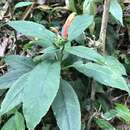Comprehensive Description
provided by North American Flora
Centropogon solanifolius Benth. PI. Hartw. 139. 1844
Centropogon proslralus Benth. PI. Hartw. 212. 1845. {Hariweg. Kew!)
Centropogon discolor Kunth & Bouche; Kunth, Ann. Sci. Nat. III. 9: 316, ex char. 1848.
Centropogon speciosus Planch. Fl. Serres 6: 16. 1850.
Centropogon longipes Regel, Gartenfl. 3: 3. pi. 75. 1854. (Described from a cultivated plant.)
Centropogon solanifolius var. hirlellus F. E. Winimer, Ann. Naturh. Mus. Wien 46241 1933
(Cufodonlis 285.) Centropogon Austin-Smiihii Standley, Field Mus. Publ. Bot. 18: 1409. 1938. (Austin Smith A327
Field!)
Terrestrial, herbaceous or slightly woody at base; stems weak, erect or suberect, glabrous, or prickly-pubescent in the inflorescence only, 0.6-1.5 m. high; leaves relatively few, the upper ones mostly slightly reduced in size; blades thin, green or purplish beneath, papery or membranaceous when dry, glabrous above, glabrous to minutely scaberulent or bristly-pubescent beneath (the latter especially on the veins), 2.5-6 cm. wide, 9-15 cm. long, usually 2.5-4 times as long as wide, on a stout petiole 1-3 cm. long, ovate or broadly elhptic, the apex acute, with a short deltoid-acuminate tip, the base varying from cimeate to obtuse, the margins obscurely serrate or crenate with 1-4 yellow or purplish callosities per cm., the callosities slightly depressed, or slightly projecting; inflorescence erect, 12 cm. long or less (rarely up to 35 cm. and if so the flower-bracts much smaller than the adjacent foliage leaves), often subcapitate, closely 5-I5-flowered, not appearing pedunculate, the upper foliage-leaves usually gradually reduced in size up to the inflorescence; pedicels spreading, weak, 18-25 (50) mm. long in fruit, sparsely to densely short-bristly-pubescent, each with two filiform bracteoles 2-4 mm. long, 10 mm. or less above the base of the pedicel; flower-bracts foliaccous, the lowermost usually not distinguishable from a reduced foliage-leaf, the upper bracts ovate or broadly elliptic, 4-10 (25) mm. wide, 10-25 (50) mm. long, toothed; flower 4.5-7 cm. long, including hypanthiuin and stamens; corolla "scarlet-red" (according to Austin Smith), "scarlet" (Austin Smith, Standley), "bright red," "crimson" (Stork), the lobes "orange," "yellow," or "salmon chrome" (Austin Smith;, glabrous within, the outer surface glabrous, puberulcnt, or sparingly bristly, the hairs usually little-enlarged at base, and nearly colorless, the lobes prickly near tii)S on margins, with conical hairs 0.3 mm. long or less, the tube 35-47 mm. long, slightly curved, narrowest in the proximal third and gradually enlarged to the base of the lobes, usually not abruptly enlarged nor bent, the lobes acute to acuminate, falcate, the two ui>per ones oblong, 2.5-5.0 mm. wide at base, 7-12 mm. long, conspicuously decurvcd near the apex, the lateral and lower lobes shorter, deltoid, 5-8 mm. long; filament-tube (38) 43-58 mm. long, much exscrted, yellowish, glabrous (rarely sparsely hirsute at the very base of the anther-tube), the filaments distinct below and fused to the corolla-lul>c for about 10 mm. from the base; anthertube 6.0-8.5 nun. long, violet-gray with darker stripes (according to Austin Smith) or leadcolor (according to Penland), slightly or not at all incurved, the two shorter anthers densely white-tufted at tips, the hairs concrescent into a deltoid process 1.5-2 nun. long, the anthers glabrous on backs or sparsely hirsute on the connectives, especially near base and apex; hypanthium in anthesis hemispheric, the base usually flattened, glabrous to bristly-pubescent, in fruit becoming a (dry?) berry, scarcely inflated, broader than high, 7-12 mm. in diameter; calyx-lobes lanceolate or narrowly deltoid, rounded or somewhat dilated at base, tapering gradually to a long-acute tip, glabrous or bristly-pubescent, entire or sparingly denticulate, 1.5-2 mm. wide at base, 3.5-7.5 (9) mm. long; seeds about as long as wide, flattened, with obtusely rounded edges, pale brown, conspicuously foveate-reticulate, their greatest length about 0.7 mm.
Typb locauity: Ecuador ("In montibus Paccha"), Hartweg 779 (Kew!).
DiSTRtBUTiON: Costa Rica, at elevations of 1300-3000 m.; in the Andes from Ecuador to Colombia and Venezuela.
- bibliographic citation
- Rogers McVaugh. 1943. CAMPANULALES; CAMPANULACEAE; LOBELIOIDEAE. North American flora. vol 32A(1). New York Botanical Garden, New York, NY

